X
At Youphoria villas we are locals and we know everyone around. Our on site host will assist you in organizing different experiences while you stay with us. Why not take advantage of our complementary guest concierge service.
We pride ourselves to be able to answer any question. We can arrange experiences for you such as days out or you assist with suggestions on various things such as:
This new and interesting venture lies only 18 kilometers outside the city of Chania, in the foothills of the magnificent White Mountains.
Nearly 20 hectares of land are waiting to welcome you, full of fruit trees from all over the world, herbs, medicinal and ornamental plants in a park different from others, where the land’s formation and the region’s microclimate make it a paradise for hundreds of plants, insects, birds and animals.
When you first see the Park and its facilities, it is impossible to imagine that this is the same expanse of the 20 hectares which burnt to the ground in the fires of 2003. Today it is literally reborn from the ashes and in the midst of this colorful landscape stands a burnt centennial olive tree, a memorial and a reference to the dismal fires.
In place of the grey landscape stands an educational park where you will see more than 150 species of fruit trees, dozens of herbs, medicinal and ornamental plants. Enjoy wandering through the paths of the Botanical Park at a leisurely pace and truly appreciate the beauty surrounding you.
The dramatic scenery comprises rare samples of the local flora and fauna, as well as tropical and subtropical species from all over the world and with new samples added daily, the ever changing look of the Park provides visitors with a motive to enjoy it over and over again!
The lush landscape is completed by a lake in the lower part of the Park, which is home to ducks, geese and other waders (some rare species). The park also has an open air, stone amphitheatre where events and talks are held during the season.
Any time of the season, you will be impressed by the colors, fragrances and variety of species. Depending on the time of the year, you will have the opportunity to enjoy flowers, plants and trees through all phases of their life-cycle, parallel to the various species of wild flora and fauna which they attract each season.
During the high summer months (June, July, August), the best time to schedule your visit is early in the morning to avoid the strong heat. You can complete your experience with a delicious meal in the park’s restaurant which uses only local, organic and seasonal produce.
April to November: every day from 8:30 a.m. to 8:30 p.m.
Admission: 5€ (age 12 and under go free)
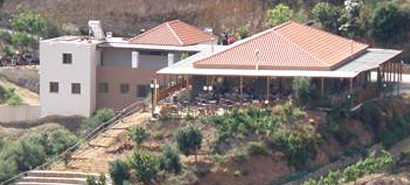
Getting there:
The easiest way to get there is by car along the National Highway heading east, then take the right turning signposted for Omalos. Continue following this road towards the mountains for several kilometers and shortly after you pass through the village of Fournes and before the historical Lakkoi-Skordalou, a sign will direct you towards the Botanical Park.
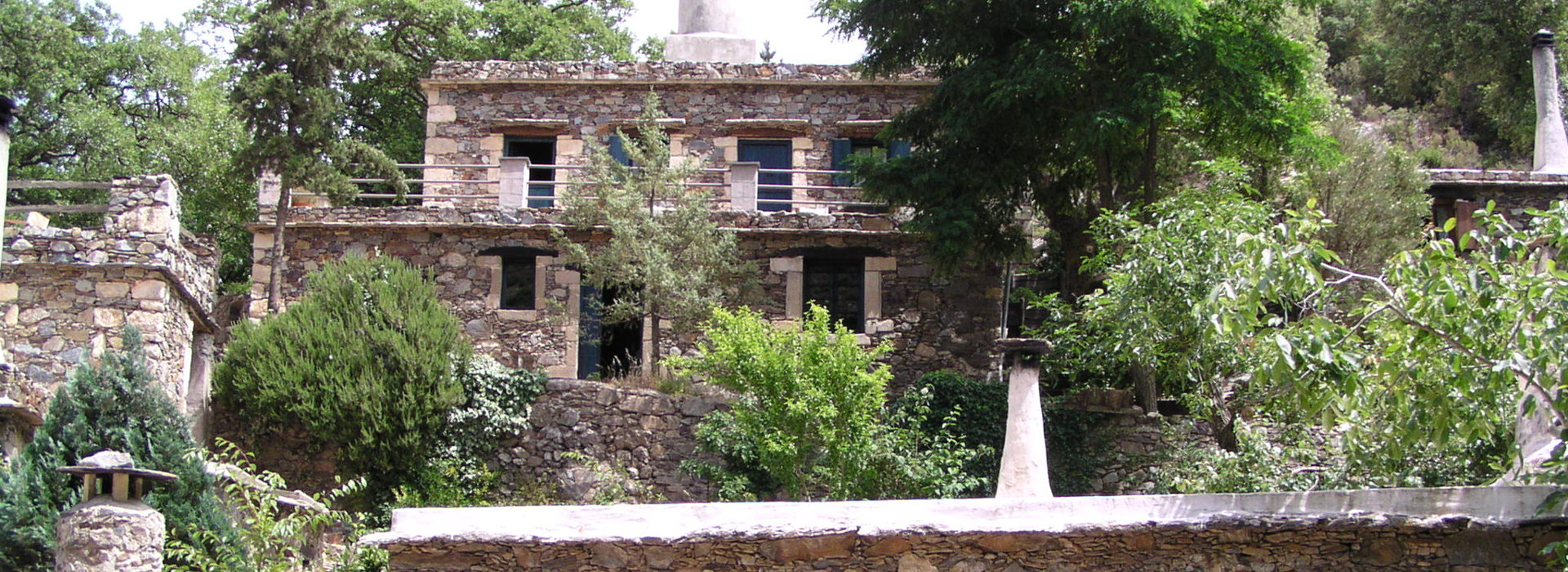
Getting there:
The only way to get there is by car and it’s quite an adventure! From Kissamos, follow the directions to Elafonissi passing through the villages of Kaloudiana, Potamida and Boulgaro. As you reach the next village of Topolia, continue left at the crossroads to Katsomatados and after 3 kilometers you will see the sign for Milia to the right.
Milia is an authentic 17th century mountain settlement which has been transformed into an eco-friendly tourist complex which seems to have sprouted from the lands of Crete.
Restored Village of MiliaEcotourism, agrotourism, ecology, the ‘great outdoors’ and respect to humanity and its needs: simplicity, harmony, clean air, warm hospitality, relaxed atmosphere, home-cooking is what you will find there.
The settlement of Milia was abandoned in 1948 and from then on, began the gradual degradation of the environment. Uncontrolled hunting and shepherding, forest fires and the depletion of local resources were just some of the unforgivable acts. In 1982, Milia was brought back to life with the focus on respect of the local environment.
Slowly, the surrounding lands were cultivated with organic produce and a certain number of domesticated animals including lambs, chickens, pigs and cows were introduced to graze the area. Reforestation efforts were also put into place as well as the creation of terraced gardens on the inclined face of the mountain so as to avoid erosion.
Set amongst plane trees, chestnut trees and mountain tops reaching the skies, its glorious location boasts exceptional rugged beauty in the area of Kissamos and overwhelms visitors with its unique diversity.
Restaurant
Restored Village of MiliaAt Milia, you will taste Cretan cuisine at its very best such as dairy products, Cretan rusk bread, olives, abundant fresh vegetables, wild greens, free range meat and of course, extra virgin olive oil. Cooking is done in a wood burning oven or with the use of natural gas and traditional techniques include rich stews, wood-oven baked delicacies and some barbequed dishes.
Opening hours
The restaurant is open every day all year round from 12pm to 21:30pm for all visitors.
In July and August the restaurant stays open until 22:30pm.
Just a few kilometers inland from Kolymbari and within a Protected Denomination of Origin (PDO) area, are the olive groves of the Astrikas Estate.
They were acquired by the Dimitriadis family in the mid-18th century and are farmed today by the 5th generation descendant Giorgios Dimitriadis who founded Biolea in 1994.
Biolea specializes in estate-produced stone-milled and cold-pressed organic olive oil. The company’s aim is to achieve excellence in the quality of its products by combining the benefits of the traditional method of oil extraction with modern equipment and knowledge, while respecting the environment by managing wastes and promoting sustainable agriculture. Since its inception, Biolea has gained a high reputation in gourmet and health food markets all over the world.
Biolea is an artisanal olive oil and is a true representation of its place of origin, reflecting the uniqueness and the organoleptic properties of the soil and micro-climate in the region.
Visiting
Biolea’s stone-mill was built specifically to welcome tourists and to hold presentations and olive oil tastings. The factory stays open all year: tours are by appointment only. Tel: 28240 23281.
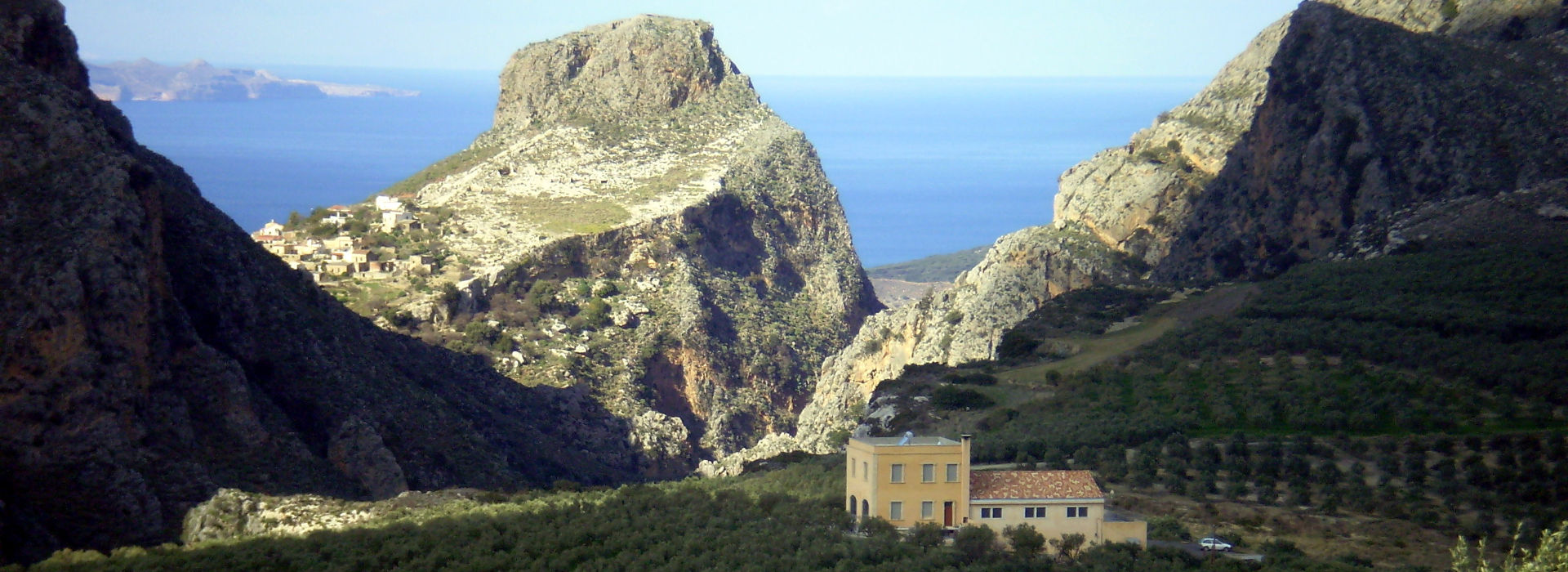
Getting there:
The only way is by car so, head west on the highway towards Chania and at the Kolymbari junction, turn right towards Spilia. Keep on the same road, passing through the villages of Spilia, Drakona, Episkopi and finally Astrikas and on the hilltop to the right, you will see Astrikas Estate.
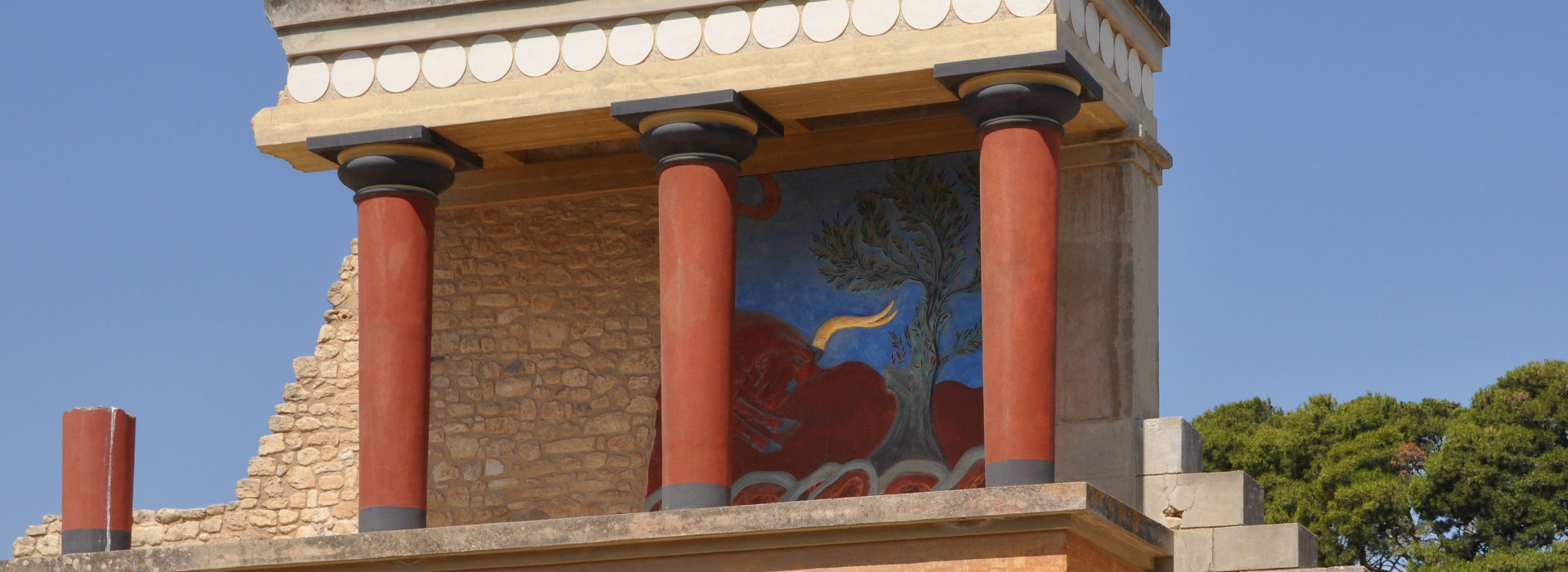
Getting there:
If you have your own car, join the National Highway and just keep driving east towards Heraklion for around 200km and you will see Knossos Palace signed to the right just after reaching the outskirts of the city.
There are public buses (KTEL) going to Heraklion from Chania every hour throughout the day. The journey takes around 2 hours 45 minutes and costs 14€ for a one way ticket. If there are several people in your party, you could share the cost of a taxi which is around 200€.
Located close to the modern city of Heraklion is Knossos Palace, the ancient city of Crete and the largest archaeological site on the island.
The site was occupied before 3000 BC and was the centre of an important Bronze Age culture. A study of the great Palace and other sites around Crete has formed the knowledge of the Minoan civilization that we know today.
The city was destroyed by earthquake before 1500 BC and was rebuilt in all its original splendour only to be destroyed once again around 1400 BC at the hands of invaders from the Greek mainland, marking the end of the Minoan culture.
Knossos later became a flourishing Greek city whose existence continued through the Roman period to the 4th Century. Greek legend has the Palace as the capital of King Minos and the site of the labyrinth.
The palace was excavated and partially restored under the direction of Sir Arthur Evans in 1900. Its size far exceeded his original expectations and from the layering of the palace, Evans developed “de novo” an archaeological concept of the Minoan civilisation that used it.
With a population of around 15,000, the town of Kissamos has plenty of character and like all of Crete, it has a long history filled with legends and tradtions.
It offers peace and quiet away from city life with many tavernas where you can sample traditional Cretan cuisine, taste the Bay’s fresh fish and relax with a famous wine from the Kissamos area.
The town itself has many amenities such as banks, post office, health centre, pharmacy, car & bike rentals, bakery and shops selling local arts and crafts. The sandy beaches are uncrowded and give you the opportunity to swim in the turquoise waters of the Aegean Sea.
Archaeology
Looking back over the centuries, Kissamos has a turbulent history through Post-Neolithic times, Minoan, Mycenean, Roman, Byzantine and Venetian periods.
Kissamos: The capital of the province is named after the ancient settlement situated where the current town is. Various places of archaeological interest such as Roman baths, a cemetery, an aquaduct (Kria Vrisi),mosaic floors, a sanctuary from the Mycenean era (Seli) and part of the Venetian fortress in the form of a pentagon survive to this day.
Polyrrinia: An important ancient city and the best fortification in the area, part of its walls, rock carved houses, tombs, a temple with huge altar, Roman ruins and a magnificent aquaduct built by Adrianos still exists.
Falsarana: An ancient seaside naval town with a port built during Hellenistic times. Today you can still see the foundations of houses, part of a stronghold wall, a throne and the ancient port.
Gramvousa: On the small pirate island of Gramvousa stands a castle built in 1584 which played an important role in the Turkish occupation and the Cretan revolution due to its strategic position.
Agnion: An ancient temple devoted to the god Apollo.
Potamida: A hidden school and the geological phenomenon of “Komolithi”.
Saint Sofia: A church built inside an impressive cave high up a sheer rockface in Topolia Gorge.
Chrisoskalitissa: A clifftop monastery whose name comes from the Byzantine era when its last step is made from gold (“hryso” meaning gold and “skala” meaning stairs).
Lousakies: Temples from the time of the Venetian occupation.
Kalathenes: Venetian fortress and “Rotunda” villa.
Mythimna: Ancient city of the Minoan age
Kefali: A Greek Orthodox temple with frescoes and Venetian villa called “Kalergon Tower”.
Gonia: A monastery built during the 17th Century with a great collection of Post-Byzantine icons and religious artifacts.
Dictyna: A church and sanctuary devoted to the goddess Artemis-Dictyna.
Gorges
The characteristic gorges of Crete represent the geological formation of the landscape and combined with the wildlife, bushes, aromatic herbs and enchanting birdsong, create a very special audio-visual pleasure.
Sirikari: Through a National Forest, the gorge stretches from Sirikari to Kissamos for 17 kilometers and with sheer cliffs and narrow paths, in places it can be difficult to pass. Occasionally, in the spring or after heavy rainfall water will flow down the ravine nourishing the small forest of Sycamores and local wildlife.
Τopolia Gorge: This gorge runs from Katsomatado to Topolia and is an easy 4 kilometers. It is majestic and wild with rich vegetation and many caves including Agia Sofia.
Rokka: With a wealth of flora and fauna, Rokka is just 1 kilometer in length and begins to the north, close to the mansion of Saint Makris.
Halases: This impressive gorge is 2 kilometers long and starts at Malathryo ending at Mouri. A stone built bridge spans the gorge at the beginning and the path follows a natural tunnel from which flows the River Anilios
Walking
Kissamos – Kaliviani – Balos (14.5km): Kissamos – Kaliviani – 5km – 1 hour 15 minutes. Kaliviani – Balos – 9.5km – 2 hours 30 minutes.
Kissamos – Kaliviani – Falsarna (9.5km): Kissamos – Kaliviani – 5km – 1 hour 15 minutes. Kaliviani – Azogiras – Falasarna – 3.5km – 2 hours.
Kissamos – Nopigia – Ravdouha – Rodopou (14km): Kissamos – Nopigia – 5.5km – 1 hour 30 minutes. Nopigia – Ravdouha – 5km – 2 hours 15 minutes. Ravdouha – Rodopou – 3.5km – 1 hour 30 minutes.
Sirikari – Polyrrinia – Kissamos (14km): Sirikari (gorge) – Polyrrinia – 7km – 2 hours 40 minutes. Polyrrinia – Kissamos – 7km – 2 hours.
Platanos – Lousakies – Kissamos (10km): Platanos – Lousakies – 4km – 1 hour 30 minutes. Lousakies – Kissamos – 6km – 2 hours.
Koukounara – Polyrrinia – Galouvas – Fterolaka – Falasarna (13km): Koukounara – Polyrrinia – 3km – 1 hour 30 minutes. Polyrrinia – Galouvas – Fterolaka – 2.5km – 1 hour. Fterolaka – Falasarna – 6.5km – 2 hours 30 minutes.
Katsomatados – Mouri – Voulgaro (11.5km): Katsomatados – Mouri – 8km – 3 hours. Mouri -Voulgaro – 3.5km – hour.
Sasalo – Katsomatados – Topolia (8km): Sasalo – Katsomatados – 4km – 1 hour 20 minutes. Katsomatados – Topolia – 4km – 1 hour 15 minutes.
Rodopou – St John – Rodopu (15km): Rodopou – St John – 6.5km – 2 hours. St John – Rodopou – 8.5km – 3 hours.
Tavernas
Gramvousa Restaurant (4km): Traditional Cretan cuisine, just through the village of Kaliviana. Tel: 28220 22707
Sunset Taverna (15km): Unspoilt beachside taverna serving locally grown, organic cuisine along the south west coast. Tel: 28220 41627
Scuba Diving
Scubaplex: Located on the main road through Kissamos. Email: [email protected]
Kissamos Diving Centre: Located on the main road through Kissamos, just after exiting the town heading towards Chania. Tel: 28220 24248
AquaSport Dive Centre: Beach Road, Kissamos. Tel: 28220 83375
Cycling
Autofun: Tel: 28220 23440
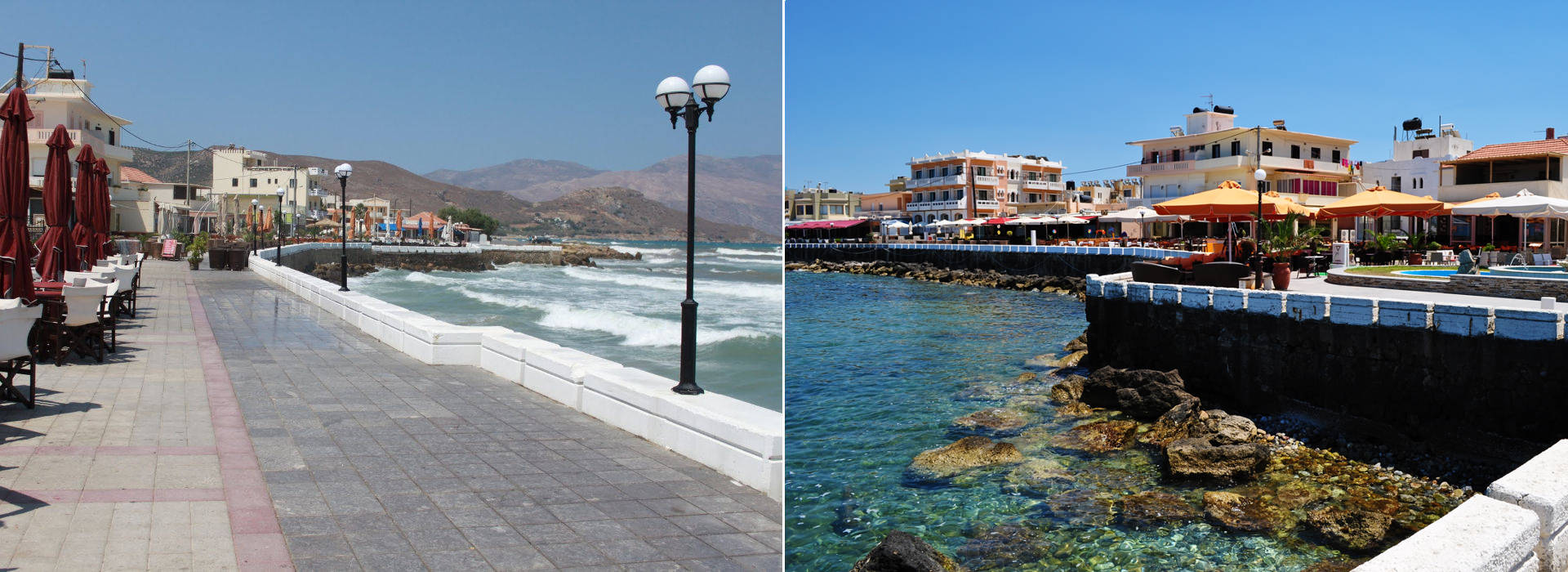
Getting there:
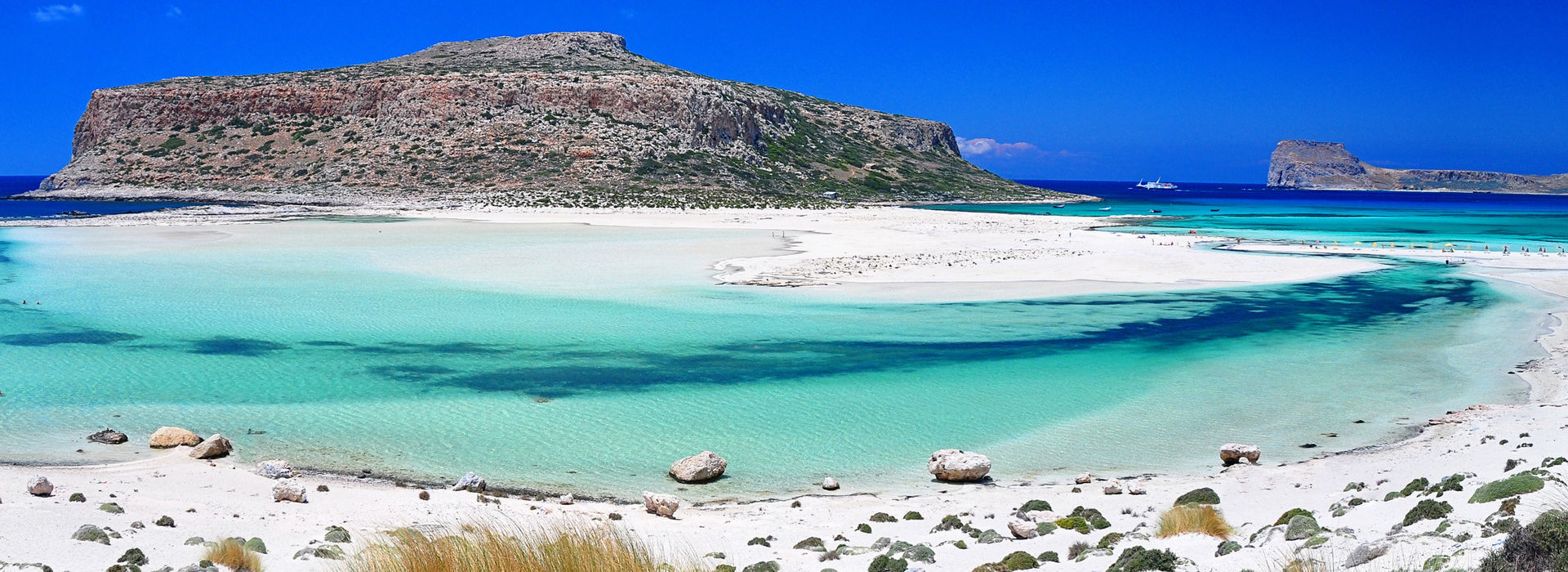
Getting there:
From May to October, you can take daily cruises from Kissamos port to to Gramvousa Island and Balos Lagoon, leaving in the morning and returning in the evening.
From mid-June and until mid-September, there are also midday departures.
Why you would want to visit?
For the spectacular beaches and fascinating geological aspects, the flora (especially in the spring), the archaeology (Venetian castle) – and of course the fun of a boat trip!
About Gramvousa and Balos:
History: Gramvousa (also called Tigani peninsula). The castle on top of the island was built by the Venetians to protect Crete from a Turkish occupation. It was one of the last unconquered bastions and it was the first area of Crete to be liberated from the Turks in 1825 (Turks were expelled from all the rest of Crete only by 1898). 3000 Cretan rebels were planning operations from Gramvousa.
During this period of turmoil, the residents of the island started looting boats passing through, which gained the island its pirate reputation.
Flora: The Gramvousa/Balos region is a protected biotope. There are 400 different plants on Gramvousa, 26 of them endemic to Crete. The Anthemis glaberrima (a type of daisy), the Allium platakisi (a wild onion) and the Silene litegripetala are found only in this area and are protected species.
In the shallow parts of the sea, the Mediterranean plant Posidonia oceanica thrives, providing shelter for marine life.
Fauna: 98 bird species have been reported in the area. 20 of them are protected and 14 of them are threatened species (like the vulture Europe Gypaetusbarbatus). The Mediterranean seal (Monachus Monachus) and the Caretta Caretta turtle find shelter in this area. Also, a flock of wild donkeys lives on the peninsula!
Balos bay and lagoon: Clear waters and desert-isle sand, an exceptional place in a wind-protected area of the sea.
The gorge of Samaria is situated in the National park of Samaria, in the White Mountains in West Crete. The park is supervised by the Department of Forestry and the gorge is generally open only from the beginning of May to the end of October.
In winter, high water makes the gorge dangerous and impassable. It will also be closed on rainy days (too dangerous because of rock falls).
The gorge is open only during the day time and if you want to start walking in the afternoon you will only be allowed in up to a certain point. The guards want to make sure that everybody who walks in also gets out before nightfall. This is the reason why they ask you to present your ticket on the way out as it (supposedly) enables them to know if there is anyone still in the park at night.
When is the best time to walk through the gorge?
The problem with Samaria is the crowds. It has become one of the” musts” if you go to Crete and there are up to 3,000 visitors a day on very busy days. Starting at dawn (before the tourist coaches arrive) will give you a bit of a head start. It is possible to find good (and cheap) accommodation in Omalos.
The first tourist buses arrive at around 7.30 am and from then on it is an uninterrupted stream of buses until about 11.00 am. You can also start walking after 12.00, there won’t be many people but you will most probably need to spend the night in Agia Roumeli because the last boat out will have left when you get there.
As far as the times of the year are concerned, the best time is in the spring: the weather is still cool and the vegetation is at its best. The worst time is in the middle of the summer during a heat wave. Give it a miss and come again at a better time.
Getting there
If you get there with your own car you will be forced to get back to Omalos to retrieve it so it is not such a good solution.
There are public buses (KTEL) going to Omalos from Chania every morning (only when the gorge is open). Once in Agia Roumeli you take one of the boats returning to Hora Sfakion (or Sougia and Paleochora if you prefer although there is no connecting bus to Chania) and take an evening KTEL bus back to Chania. If you are not alone, why not share a taxi to Omalos? The cost from Chania is around 50€ for up to 4 persons.
The most common way to “do” the gorge is to book an organized tour which can be done from Kissamos. You will be picked up from and returned to an agreed location. The buses are air-conditioned and you have the benefit of a guide. This does not mean that you need to walk in a group: everyone walks at their own pace and meets at a pre-arranged time and place in Agia Roumeli.
What to take with you on this walk?
What sort of terrain will you encounter?
Stones, stones and yet more stones! The terrain is stony and rocky most of the time but it varies. At the beginning, the path is paved with uneven stones, then at times it is more like a forest path with some earth. Once you reach the river bed you walk mainly on pebbles (tiring on the sole of the feet). You also have to cross the river at least a dozen times, sometimes on small wooden bridges but more often by stepping on rocks. These have been placed at strategic intervals but still require some sure-footedness. The only easy path is once you leave the southern end of the National Park: it is flat and there are no stones, no shade either so the last 3 km can be very hot in high summer.
How long does it take and how fit do you need to be?
A walk of 16 km on flat ground should take about 3 hours if you walk at a brisk pace. This is, theoretically, quite easy in the gorge of Samaria as you are going down most of the time. If you do not know the way and are not that used to walking on Cretan terrain (even if it is a very good path by Cretan standards) you will need quite a bit longer of walking time. You should allow 4 hours although some may need a little longer, especially if you take a long time covering the first 2 km which are very steep and require a little bit of experience and strong knees to walk at a good pace. Add to this time to rest, look at the scenery, take photographs and you can count about 6 or 7 hours to cover the entire distance.
The walk is long and can be arduous but it is not difficult. Still, every day people get into trouble or end up having an experience which is far from pleasant. The most common factors are:
k
Taking children
Most young children have no problems walking but will not hold the distance. You might end up having to carry them which is nobody’s idea of fun on such a long walk. It is not recommended to take children younger than 8 or 9 years. From that age onwards, they generally have far less problems than their parents but they tend to walk a little too quickly, jump about …and fall. Make sure you have them in sight most of the time (or at least ensure that you know if they are in front of or behind you!) and try to get them to slow down when they get carried away.
Taking your dog for a walk
You may take your dog with you in the gorge provided it is on a leash at ALL times.
Various advice
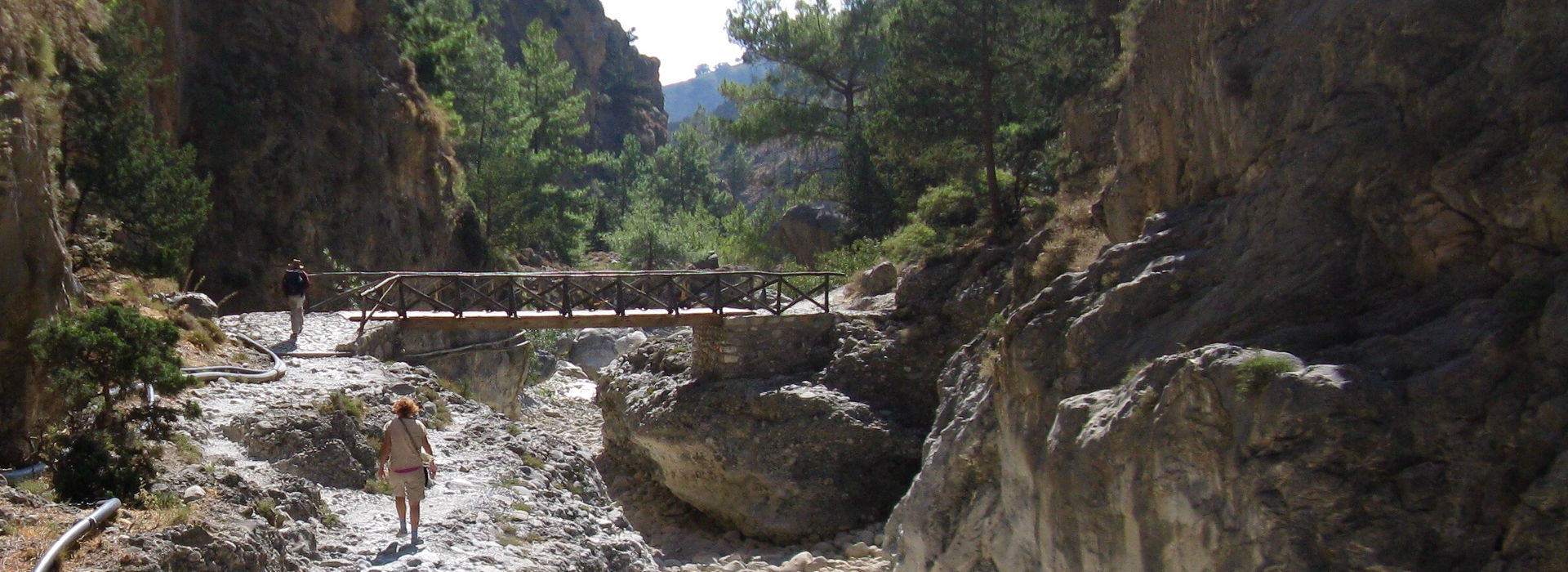
Getting there:
If you get there with your own car you will be forced to get back to Omalos to retrieve it so it is not such a good solution.
There are public buses (KTEL) going to Omalos from Chania every morning (only when the gorge is open). Once in Agia Roumeli you take one of the boats returning to Hora Sfakion (or Sougia and Paleochora if you prefer although there is no connecting bus to Chania) and take an evening KTEL bus back to Chania. If you are not alone, why not share a taxi to Omalos? The cost from Chania is around 50€ for up to 4 persons.
The most common way to “do” the gorge is to book an organized tour which can be done from Kissamos. You will be picked up from and returned to an agreed location. The buses are air-conditioned and you have the benefit of a guide. This does not mean that you need to walk in a group: everyone walks at their own pace and meets at a pre-arranged time and place in Agia Roumeli.
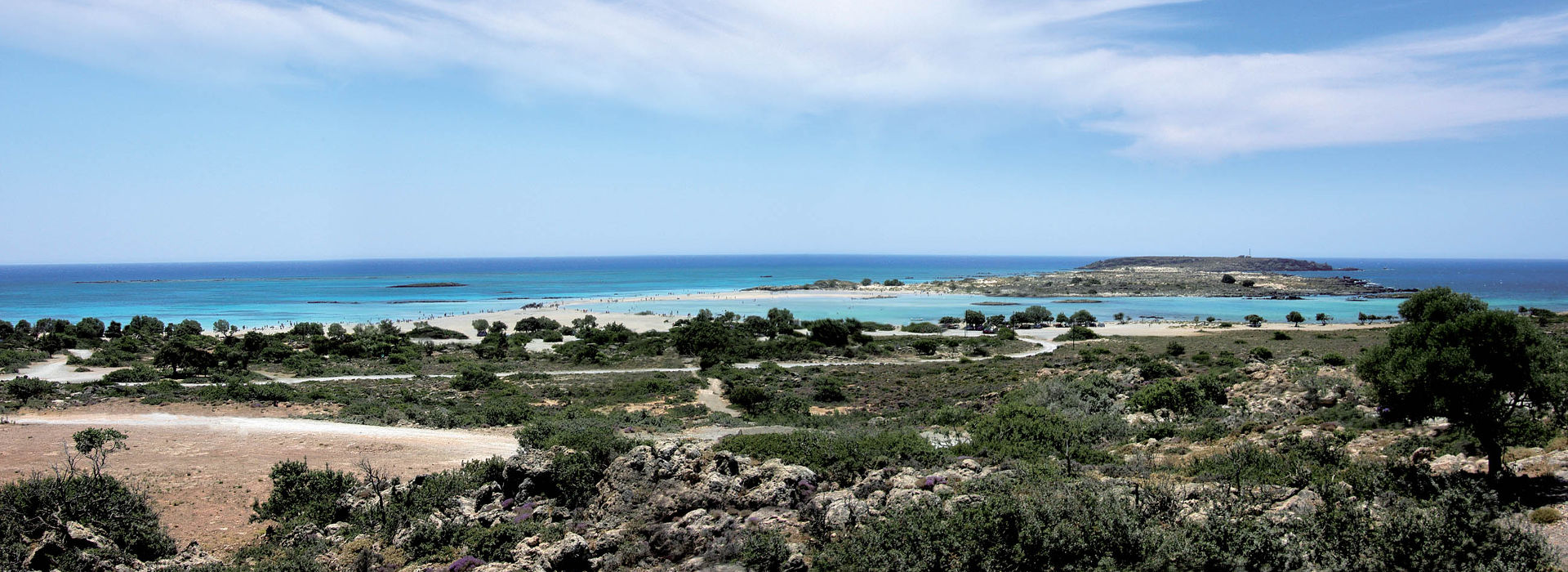
Getting there:
Elafonissi is in west Crete, about 45 kilometres southwest of Kastelli. The Elafonissi area includes the beach, the islet 200 metres offshore and the shallow lagoon between the two.
Elafonissi is a tiny island with white sand, separated from the shore by a lagoon no more than a metre deep. Elafonissi means “deer island”, but you won’t see any deer on the island or in the surrounding area.
On the way, you will see Chrissoskalitissa Monastery, visible from afar as it is dazzling white and built high on a great rock. Climb up to pay your respects at this historic monastery and look for the golden step which, according to legend, only the truly devout can see.
Elafonissi is 5 kilometres from Chrissoskalitissa. On arriving you will see a large bare expanse used as a car park, a few dusty juniper trees and the wonderful colours of the lagoon. The island is less than 200 metres from the beach and you can easily walk there through the warm, shallow water of the lagoon. On reaching the island you will discover lots of tiny beaches on its south coast.
The sand of Elafonissi is white, but in many places it is pinkish due to the thousands of broken seashells it contains. The limpid, blue-green waters will remind you of an exotic paradise.
Thousands of people visit Elafonissi each summer, reaching 2,500 daily in July and August, so if you want to enjoy the island it’s much better to come at the beginning or end of the summer or avoid the hours from 11 to 4, especially at weekends. There are a few rooms for rent and tavernas nearby.
Take a boat ride
The “Island Escape” takes a daily trip from Elafonissi south along the coast to the deserted bay of Kedrodasos. You can swim and snorkel from the boat and admire the cedar woods lining the beach, most of which are over 200 years old.
Then, onto Lake Krios and the site of Ancient Vienna where you will see marble columns lying underwater and on the beach. It is said that a temple once stood here during Hellenistic/Roman times and in the surrounding area, shards and potsherds of urns and amphora can be found still.
You may even be lucky enough during the voyage to see dolphins and the Caretta-Caretta (Loggerhead Sea turtle) which frequent the area at certain times of the year.
The massacre in 1824 at Elafonissi
Seeing the idyllic beauty for which Elafonissi is famous, it is hard to imagine that its name is linked to tragic events. Here the Turks massacred 850 people on Easter Sunday 1824. The massacre was carried out purely in revenge to punish the rebellious Cretan people, as the victims were mostly women and children.
The sinking of the Imperatrix at Elafonissi
In February 1907, the SS Imperatrix ran aground on the reefs around Elafonissi, with the loss of 38 of the 140 people aboard who were travelling to India (120 crew and 20 passengers). The monks of Chrissoskalitissa Monastery and the few local inhabitants threw themselves into the wild breakers and managed to save 38 people.
To prevent similar accidents in future, a tall lighthouse, visible at a great distance, was built on Elafonissi, to warn sailors to stay away from the dangerous rocks. Unfortunately all the junipers and other trees on Elafonissi were sacrificed to build the lighthouse. The lighthouse was destroyed by the German army during the Second World War, and has now been replaced by a modern structure.
Paleochora is a delightful small town on the south coast of Crete just oozing with charm and character. It’s beauty, tranquility and laid-back feel has earned it the affectionate term of “The bride of the Libyan Sea”.
Capturing your attention are Paleochora’s enchanting whitewashed houses draped in oleander and bougainvillea, pretty pathways and streets with cosy cafés sporting decorative facades, and a wonderful tree-lined ‘urban boardwalk’ lit by wrought iron street lanterns.
Paleochora has 2,000 permanent residents who held a town meeting many years ago in which, they unanimously decided it was their job to keep all tourists happy (that’s an ongoing joke). So successful are they at this, that tourists are treated like special guests attending the star bride’s wedding feast – and it’s a perpetual one!
The resort is ideal for outdoor activities such as swimming, windsurfing, fishing, scuba diving and hiking. There are also many restaurants and tavernas, bars and cafés that add to the vibe created by the hippies when they discovered Paleochora in the 60’s.
There is a daily ferry to the village of Agia Roumeli at the foot of Samaria Gorge and which is only accessible by boat. From here, it is possible to walk a few kilometers up the Gorge as far as the Iron Gates and is locally known as “Samaria – The Lazy Way”!
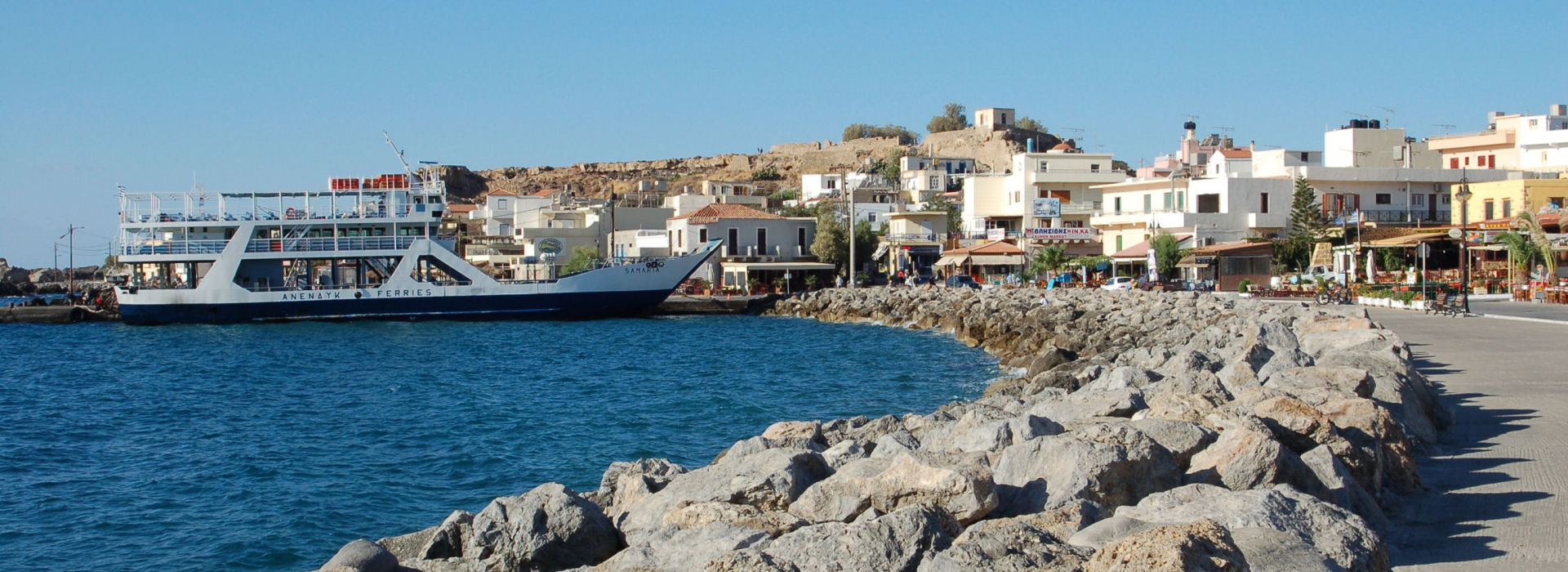
Getting there:
The 1 hour journey by car from the north to south coast starting at Tavronitis, is the best way to get there as the winding road takes you through some breathtaking scenery on the edge of the White Mountains with plenty of opportunity to stop and take photos.
There are public buses (KTEL) from Chania to Paleochora 4-5 times a day over the summer months which take 90 minutes and cost 8€ one way. The last bus returning to Chania leaves Paleochora at 6pm.

Getting there:
Public transport is very limited and you will need your own car if you want to be able to move at all. The nearest town (Kastelli) is about 20 km away. The nearest airport at Chania is about 50 km away.
Falassarna is a peaceful and golden sandy beach with beautiful clear turquoise waters.There are just a few simple tavernas and not much to do but except walk and absorb the wild beauty of the area or relax in the sun. The beach is wide and seemingly endless.
In the hills behind the beach, you will find the ruins of the ancient city and harbour of Falasarna.
Ancient Falasarna
The excavations of the ancient city of Falasarna have exposed some of the walls and buildings of the city. The geographical shift (rise) of Crete has put the ancient harbour on dry land. Falasarna was a commercial naval power during the Hellenistic period and also the harbour of Polirinia.